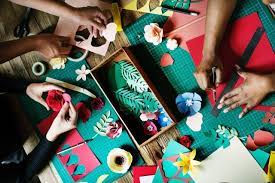Starting an online business selling art and crafts can be a fulfilling venture, especially if you have a passion for creativity and a desire to share your work with the world. Here’s a step-by-step guide to help you launch your online art and crafts business successfully:

Table of Contents
ToggleStep 1: Identify Your Niche
The first step in starting your online art and crafts business is to identify your niche. Consider what type of art or crafts you enjoy creating and what you believe will appeal to your target audience. Some popular niches include:
- Handmade jewelry
- Paintings and prints
- Home décor items
- Handmade stationery
- Customized gifts
Research existing businesses in your chosen niche to understand the market demand and potential competition.
Step 2: Develop Your Brand
Creating a strong brand identity is essential for standing out in the crowded online marketplace. Consider the following elements:
- Business Name: Choose a name that reflects your style and the products you offer. Ensure it’s unique and easy to remember.
- Logo and Visual Identity: Design a professional logo and select a color scheme and font that represents your brand. Tools like Canva can help you create visually appealing designs.
- Story: Craft a compelling brand story that communicates your passion for art and crafts. Share what inspires you and what sets your products apart.
Step 3: Create Your Products
Once you have your niche and brand established, it’s time to create your products. Focus on quality and uniqueness to attract customers. Here are some tips:
- Research Trends: Stay updated on current trends in art and crafts to inform your designs and product offerings.
- Experiment and Refine: Don’t hesitate to experiment with different techniques and materials. Seek feedback from friends, family, or potential customers to refine your creations.
Step 4: Set Up an Online Store
You’ll need an online platform to sell your art and crafts. Here are some options to consider:
- E-commerce Platforms:
- Etsy: A popular marketplace for handmade and vintage items. It’s easy to set up and has a built-in audience.
- Shopify: A customizable e-commerce platform that allows you to create your own online store.
- WooCommerce: A WordPress plugin that enables you to add e-commerce functionality to your existing website.
- Social Media Platforms:
- Instagram and Facebook Shops: Showcase your products and sell directly through your social media profiles.
- Pinterest: Create visually appealing pins to drive traffic to your online store.
Step 5: Price Your Products
Pricing your art and crafts can be challenging. Consider the following factors when determining your prices:
- Cost of Materials: Calculate the cost of all materials used to create your products.
- Time and Labor: Factor in the time it takes to create each item.
- Market Research: Analyze the prices of similar products in your niche to ensure competitiveness.
- Profit Margin: Set a profit margin that allows for sustainability and growth.
Step 6: Develop a Marketing Strategy
A solid marketing strategy is crucial for attracting customers to your online store. Here are some effective marketing tactics:
- Social Media Marketing: Use platforms like Instagram, Facebook, and Pinterest to showcase your creations, engage with your audience, and drive traffic to your store.
- Content Marketing: Start a blog or YouTube channel to share tips, tutorials, or behind-the-scenes looks at your creative process. This can help establish your authority and attract potential customers.
- Email Marketing: Build an email list and send regular newsletters featuring new products, promotions, and valuable content to keep your audience engaged.
- Collaborations: Partner with other artists or influencers to reach new audiences and expand your network.
Step 7: Manage Operations
As your online art and crafts business grows, managing your operations becomes increasingly important. Consider the following:
- Inventory Management: Keep track of your inventory and ensure you have enough materials on hand to meet demand.
- Shipping and Fulfillment: Determine how you will handle shipping. Research shipping options, packaging, and costs to ensure timely delivery.
- Customer Service: Provide excellent customer service by responding promptly to inquiries, addressing concerns, and ensuring a smooth shopping experience.
Step 8: Gather Feedback and Iterate
After launching your online business, seek feedback from customers to improve your products and services. Use surveys, reviews, and direct communication to gather insights. Be open to making adjustments based on customer preferences and market trends.
Step 9: Scale Your Business
Once your business is established and running smoothly, consider ways to scale:
- Expand Your Product Line: Introduce new products or variations to attract a broader audience.
- Explore New Markets: Consider selling your products on additional platforms or in local boutiques and art fairs.
- Automate Processes: Use tools and software to automate marketing, inventory management, and customer communication to save time and focus on creativity.
Conclusion
Starting an online business selling art and crafts requires creativity, planning, and perseverance. By following these steps, you can build a successful brand that showcases your artistic talents and connects with customers who appreciate your work. Remember to stay true to your passion, continuously refine your offerings, and engage with your audience to foster long-term success in the online marketplace. Good luck on your creative journey!


No responses yet